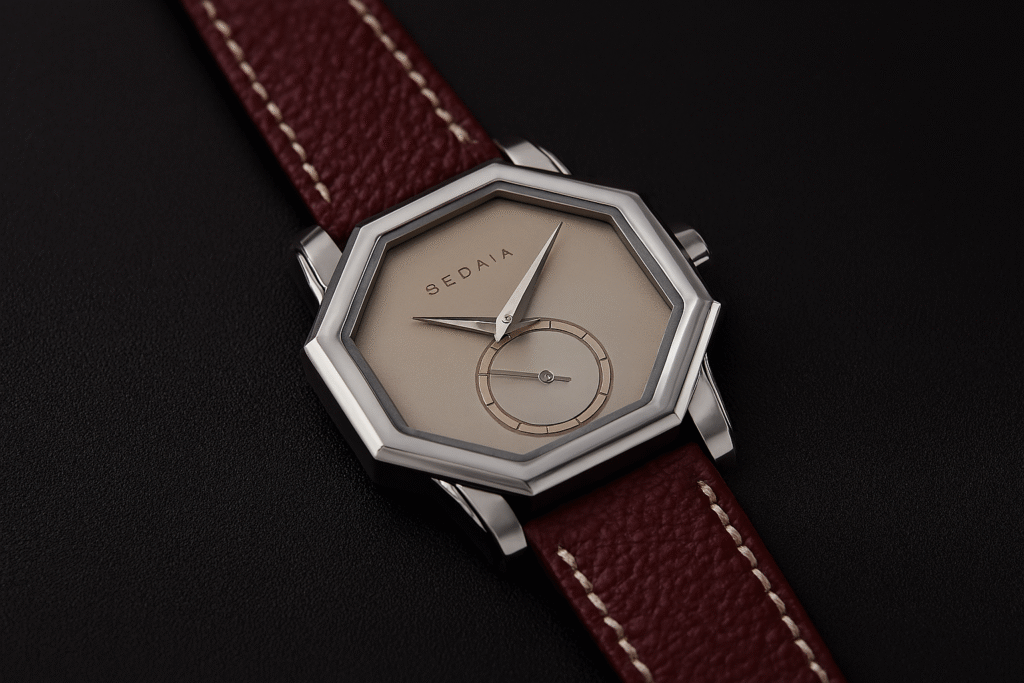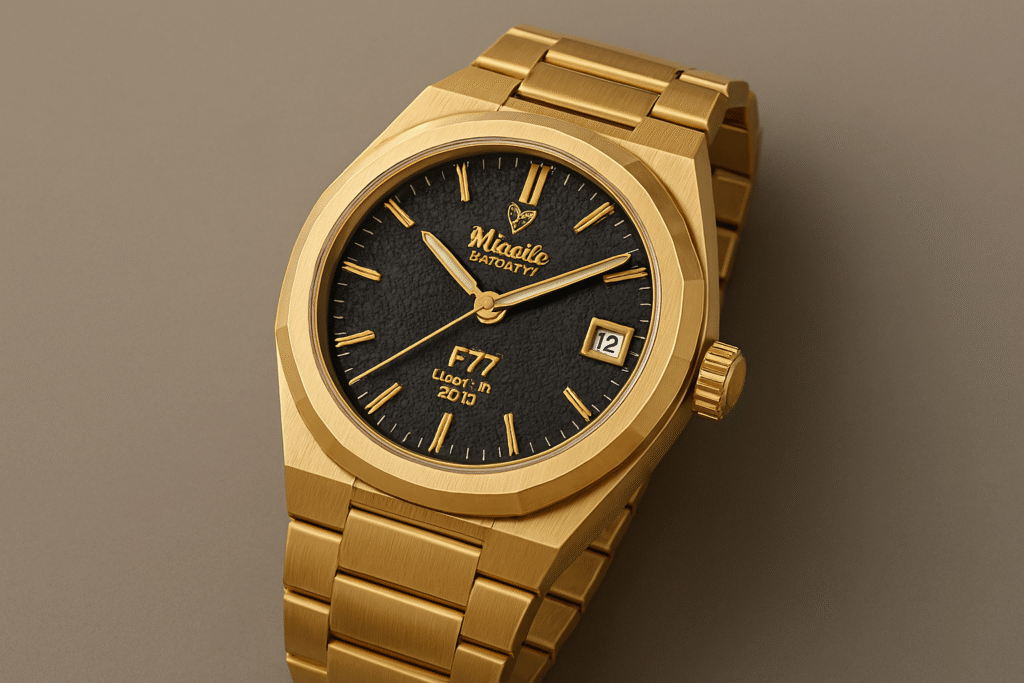The Beda’a Angles Mecaline Warm Gray represents precision watchmaking with modern Arabic heritage. Built with a 316L stainless steel case, sapphire crystal, and a 6mm slim profile, this timepiece blends durability with understated elegance.
Technical Specifications
- Case Material: 316L stainless steel
- Dimensions: 37mm x 34mm
- Thickness: 6mm
- Crystal: Sapphire
- Lug Width: 19mm
- Water Resistance: 3 ATM (30m)
- Movement: ETA 7001 (manual-wind)
- Frequency: 21,600 vph (3 Hz)
- Jewels: 17
- Power Reserve: ~42 hours
- Dial Functions: Hours, minutes, small seconds at 6 o’clock
- Hands: Dauphine-style
- Strap: Stitched Epsom leather, 19mm, pin buckle
The Journey of Beda’a
The roots of Beda’a trace back to Albidaa, a brand that began shaping regional luxury in 2016. What started as a small initiative within Albidaa quickly became a global vision. By listening to customers who wanted more distinctive designs, the brand expanded into Beda’a Watches, standing today as a watchmaker with international recognition.
Beda’a is built on three core values: craftsmanship, heritage, and global reach. Every tick of the ETA 7001 movement reflects the brand’s commitment to precision.
“The key is creating a watch that respects tradition while meeting global demand.”
Why Choose the Beda’a Angles Mecaline?
- Slim 6mm case – perfect for formal wear.
- Swiss ETA 7001 manual movement – trusted by collectors worldwide.
- Designed with Middle Eastern heritage, yet appealing to global enthusiasts.
- Epsom leather strap ensures both style and comfort.
Case Study: Regional Success
By 2020, over 65% of Albidaa’s watch sales came from repeat customers, proving the trust built around quality and service. Beda’a builds on this success by offering international shipping and wider design variations.
FAQ
Q: Is the Beda’a Angles Mecaline water-resistant?
Yes, it has a 3 ATM rating, making it safe for light splashes but not for swimming.
Q: What makes the ETA 7001 movement special?
It is a hand-wound Swiss caliber known for reliability, slimness, and 42-hour power reserve.
Q: What strap options are available?
The standard model comes with a stitched Epsom leather strap, 19mm width, with a pin buckle.
Q: Where can I buy Beda’a watches?
You can explore models directly on the official Beda’a Watches website or through authorized retailers.
Suggested Reading:
Learn more about how to buy luxury watches online safely.
Explore the guide on understanding Swiss watch movements.
Read about the best men’s dress watches under 40mm.
Compare the features on heritage watch brands from the Middle East.
This comprehensive global cuisine FAQ covers everything about Asian and Western food and drinks. Whether you’re exploring international cooking techniques or discovering new flavors, this global cuisine FAQ answers the most frequently asked questions about world food traditions, ingredients, and culinary practices from both Eastern and Western cultures.
Global Cuisine FAQ: Asian & Western Food & Drinks
Food reveals cultural contrasts in clear and delicious ways. From cooking methods to dining customs, Asian and Western cuisines showcase unique traditions while also offering fascinating overlaps. Below, you’ll find answers to the most common questions about these culinary worlds.
Understanding Core Differences in Cuisine
1. What distinguishes Asian and Western culinary traditions?
Asian meals often rely on rice or noodles as a foundation. Flavors usually come from soy sauce, ginger, garlic, and a wide variety of spices. Meanwhile, Western gastronomy emphasizes bread, potatoes, and pasta. Dairy plays a key role, with butter, cream, and cheese giving richness to many dishes. Herbs such as rosemary and thyme highlight European cooking. These contrasts create distinct dining habits and flavor profiles.
2. Are Asian dishes always spicy?
No, not at all. While cuisines from Thailand and parts of India feature bold use of chilies, not every dish follows this pattern. Japanese sushi, Chinese dim sum, and Korean bulgogi are mild examples. In fact, Asian cuisines range from fiery to delicate, showcasing a rich palette of flavor.
Western Breakfast Staples and Comfort Foods
1. What constitutes typical Western morning meals?
Western breakfasts often include eggs, bacon, and toast. Pancakes, waffles, and cereal are also popular choices. These hearty starts are usually enjoyed with coffee, tea, or juice, providing both energy and comfort.
2. What represents popular Western comfort foods?
Comfort foods in the West speak to nostalgia and indulgence. Creamy macaroni and cheese, pizza, and hearty casseroles are favorites. Similarly, burgers and fried chicken have wide appeal. Because they are warm, filling, and familiar, these dishes strongly connect to emotion.
Cultural Dining Practices
1. Do all Asian cultures employ chopsticks?
No. Chopsticks dominate in East Asia—China, Japan, and Korea. However, Southeast Asia prefers spoons and forks, while India and parts of the Middle East often use flatbreads or hands. This diversity highlights how food customs closely reflect culture.
2. Why are some Asian foods fermented?
Fermentation preserves food while also enhancing nutrition and flavor. Korean kimchi, Japanese miso, and Indonesian tempeh show how tradition meets health benefits. These foods are valued not only for taste but also for their role in well-being.
Common Western Beverages
1. What beverages are common with Western meals?
Western dining often features water, soda, or fresh juice. Alcohol also has a strong cultural connection, with wine served at European dinners and beer central in North America. In the southern United States, sweet iced tea is a staple.
Dietary Flexibility and Options
1. Can one discover plant-based options easily?
Yes. Asian cuisines offer tofu stir-fries, lentil dals, and vegetable curries that are naturally vegetarian. Western food, similarly, embraces plant-based eating. Salads, vegetarian pastas, and vegan burgers have grown popular, making meat-free dining accessible worldwide.
Unique Asian Drinks to Explore
1. What are some unique Asian beverages?
Asia provides a wide variety of distinctive drinks. Bubble tea, from Taiwan, combines tea with chewy tapioca pearls. Japanese sake, made from rice, holds deep cultural meaning. Strong Vietnamese iced coffee, sweetened with condensed milk, adds a bold twist compared to Western brews.
Portion Sizes and Dining Habits
1. How do portion sizes compare?
Western meals often emphasize large servings, reflecting abundance. By contrast, Asian meals are usually smaller yet balanced, encouraging sharing and mindful eating. This creates different social experiences around the table.
The Art of Fusion Cuisine
1. Is it feasible to integrate Asian and Western flavors?
Absolutely. Fusion cuisine blends traditions in creative ways. For instance, teriyaki burgers combine Japanese flavors with American fast food, while kimchi tacos bring Korean spice to Mexican street food. These playful mixes show how food bridges cultures.


